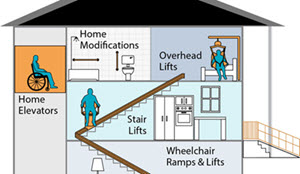Home Modifications Can Provide Barrier-Free Access
Source: cerebralpalsy.org | Re-Post CareProdx 7/21/2016

Building and home modifications provide barrier-free access and inclusion for any individual, with or without disability. Designers use the term “design for all” to describe products, services and systems designed for use by many individuals and many ability levels. The concept of “barrier-free accessibility” addresses the notion that a disability is a handicap only if it prevents a person from doing what others are able to do freely. If the barrier is non-existent, so is the handicap.
About home modifications
Home modifications address environmental barriers that prevent a person with disability from entering, utilizing, or accessing space. Barriers prevent independence and create frustration. Sometimes barriers ensure a person does not have access or opportunity.
Occupational and vocational therapists are trained to analyze an individual’s home, school, and work environments to prescribe and recommend modifications to meet specific needs. They may have contacts for bids, procurement, and funding opportunities. Once installed, they provide or arrange for instruction on how to use the new technology.
Home modifications are part of the worldwide commitment for universal design standards, which are encouraged by the World Health Organization and its member states, including the United States. Policies and regulations govern construction of government buildings, community spaces, architectural design, and public travel areas. Government housing authorities work in tandem with architectural and product design engineers to establish industry standards for structures and products that will accommodate the widest possible range of individual needs.
Click here for full article...
Recent Posts
-
How Managers Can Make Sure Buildings Are Accessible
Source: controlyourbuilding.com | Re-Post Careprodx 9/1/2016 - A moment seared into histor …3rd May 2024 -
Preferred Shower Chair Seat Height
One of the comments we hear on a regular basis is, "I don't know what seat height I need". And …1st May 2024 -
Think Twice Before Installing That Walk In Tub or Walk In Shower
We talk to a lot of people at CareProdx.com. A constant problem that arises for persons with d …1st May 2024


